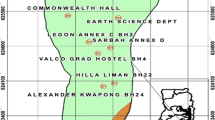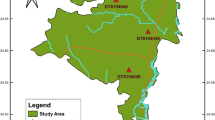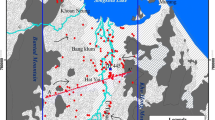Abstract
The ecosystem of South Florida is characterized by a vast wetland system, karst surficial hydrogeology, and extended coastal boundary. The ecosystem is poised under risks of: ecological failure due to increased fragmentation by urbanization; groundwater flow disruption because of sinkhole formation; and intrusion of oceanic water with decreasing water table head because of drought or over pumping. It was found important to synthesize the spatiotemporal state of the groundwater hydrology and also develop a forecasting model to support the intensive management and monitoring in place. In this study, an objective was set to develop a stochastic sequence model capable of forecasting groundwater levels on a monthly span at a daily time scale. The groundwater level simulation was conceptualized as a sequence of daily fluctuating states of magnitudes and patterns that has a defined probability of occurrence. The model setup involved representation of daily fluctuation magnitudes in ten states and pattern changes in three states. The sequential occurrence of states of magnitudes and patterns at each time step was used for estimation of the transitional probabilities and employed in a hidden Markov model frame work for ensemble generation and estimation of posterior probabilities. A realization was chosen based on the highest maximum likelihood ratio of 90% and smallest root mean square error of 0.05–0.12 m against the historical data. A monthly forecasting at daily time step was done dynamically incorporating observed data at each time step and revising prior and posterior probability estimation in the hidden Markov model formulation. A case study was conducted at three well sites, which are situated at three different hydrogeologic settings. The model not only reproduced annual groundwater fluctuation patterns but also forecasted preceding monthly fluctuations at maximum likelihood ratio above 90% and root mean square error below 0.15 m. A further study was recommended first to analyze break point parametric estimation for seasonal analysis, and secondly to integrate the approach in other hydrological models for the purpose of synthetic groundwater fluctuation generation.
Similar content being viewed by others
References
Ahmad S, Prashar D (2010) Evaluating municipal water conservation policies using a dynamic simulation model. Water Resour Manage 24:3371–3395
Aksoy H (2003) Markov chain-based modeling techniques for stochastic generation of daily intermittent stream flows. Adv Water Resour 26(6):663–671
Aksoy H (2004) Pulse generation models for daily intermittent Stream flows. Hydrol Sci J Sci Hydrol 49(3):399–411
Ali A (2009) Nonlinear multivariate rainfall-stage model for large wetland systems. J Hydrol 374:338–350
Durbin R, Eddy S, Krogh A, Mitchison G (1998) Biological sequence analysis, probabilistic models of proteins and nucleic acids. Cambridge University Press, p 356
Florida Council of 100 (2003) Improving Florida’s water supply management structure; ensuring and sustaining environmentally sound water supplies and resources to meet current and future needs. (http://www.fc100.org/documents/waterreportfinal.pdf)
Genereux D, Slater E (1999) Water exchange between canals and surrounding aquifer and wetlands in the Southern Everglades, USA. J Hydrol 219:153–168
Gunderson LH (2001) South Florida: the reality of change and prospects for sustainability; managing surprising ecosystems in southern Florida. Ecol Econ 37:371–378
Janssen J, Manca R (2006) Applied Semi-Markov processes, p 302. Springer, New York
MacDonald LI, Zucchini W (1997) Hidden Markov and Other Models for Discrete-valued Time series; Monographs on Statistics and Applied Probability 70. Chapman & Hall, London
Maliva RG, Missimer TM, Walker CW, Owosina ES, Dickson JAD, Fallick AE (2001) Carbonate diagenesis in a high transmissivity coastal aquifer, Biscayne aquifer, southeastern Florida, USA. Sediment Geol 143(3–4):287–301
Najib K, Jourde H, Pistre S (2007) A methodology for extreme groundwater surge predetermination in carbonate aquifers: groundwater flood frequency analysis. J Hydrol 352(1–2):1–15
Park E, Parker JC (2008) A simple model for water table fluctuations in response to precipitation. J Hydrol 356:344–349
Paynter P, Nachabe M, Yanev M (2011) Statistical changes of lake stages in two rapidly urbanizing watersheds. Water Resour Manage 25:21–39
Shamshad A, Bawadi MA, Hussin WMA, Majid TA, Sanusi SAM (2005) First and second order Markov chain models for synthetic generation of wind speed time series. Energy 30:693–708
Szilagyi J, Balint G, Csik A (2006) Hybrid, Markov chain-based model for daily stream flow generation at multiple catchment sites. J Hydrol Eng 11(3):245–256
Zahabiyoun B (2005) Stochastic generation of stream flow data; international symposium on stochastic hydraulics, 23 and 24 May 2005. Nijmegen, The Netherlands, Published by: IAHR, Paseo Bajo Virgen del Puerto 3, 2005 Madrid, Spain
Author information
Authors and Affiliations
Corresponding author
Rights and permissions
About this article
Cite this article
Chebud, Y., Melesse, A. Operational Prediction of Groundwater Fluctuation in South Florida using Sequence Based Markovian Stochastic Model. Water Resour Manage 25, 2279–2294 (2011). https://doi.org/10.1007/s11269-011-9808-z
Received:
Accepted:
Published:
Issue Date:
DOI: https://doi.org/10.1007/s11269-011-9808-z




